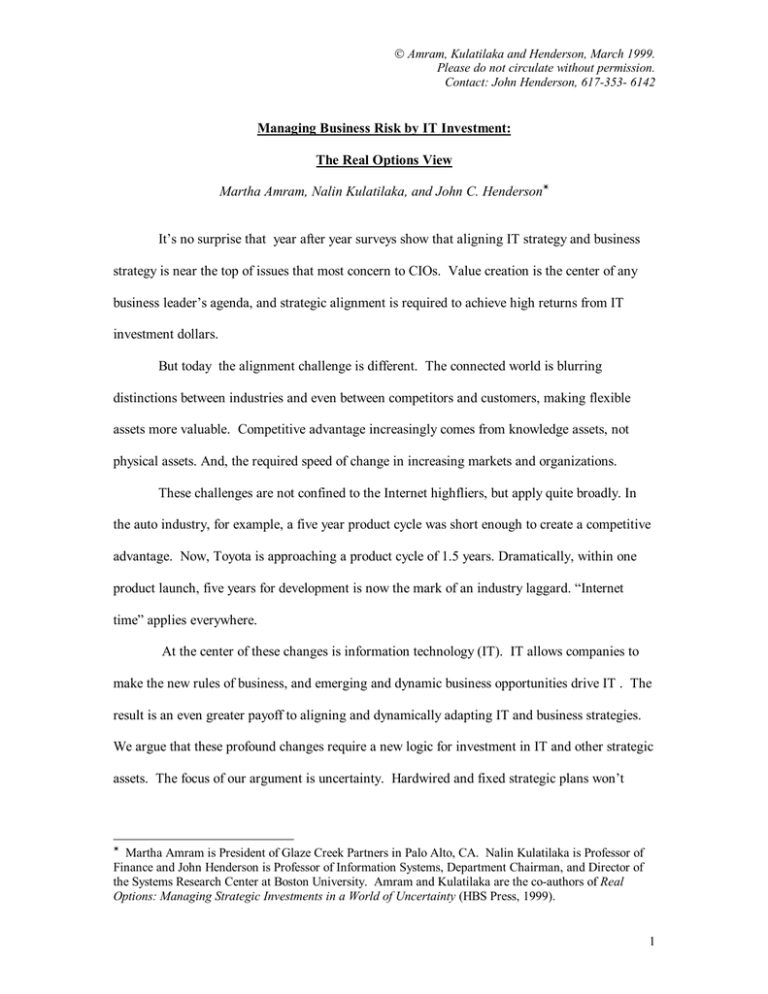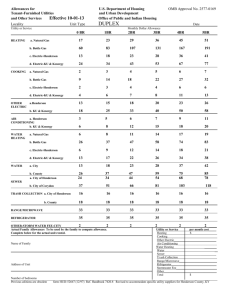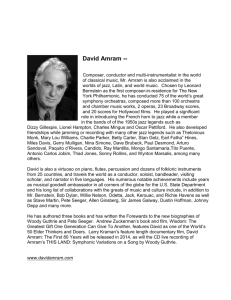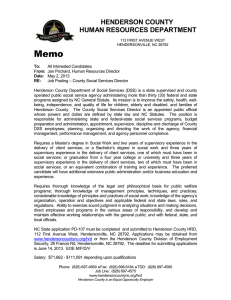Amram, Kulatilaka and Henderson, March 1999.
advertisement

Amram, Kulatilaka and Henderson, March 1999. Please do not circulate without permission. Contact: John Henderson, 617-353- 6142 Managing Business Risk by IT Investment: The Real Options View Martha Amram, Nalin Kulatilaka, and John C. HendersonW It’s no surprise that year after year surveys show that aligning IT strategy and business strategy is near the top of issues that most concern to CIOs. Value creation is the center of any business leader’s agenda, and strategic alignment is required to achieve high returns from IT investment dollars. But today the alignment challenge is different. The connected world is blurring distinctions between industries and even between competitors and customers, making flexible assets more valuable. Competitive advantage increasingly comes from knowledge assets, not physical assets. And, the required speed of change in increasing markets and organizations. These challenges are not confined to the Internet highfliers, but apply quite broadly. In the auto industry, for example, a five year product cycle was short enough to create a competitive advantage. Now, Toyota is approaching a product cycle of 1.5 years. Dramatically, within one product launch, five years for development is now the mark of an industry laggard. “Internet time” applies everywhere. At the center of these changes is information technology (IT). IT allows companies to make the new rules of business, and emerging and dynamic business opportunities drive IT . The result is an even greater payoff to aligning and dynamically adapting IT and business strategies. We argue that these profound changes require a new logic for investment in IT and other strategic assets. The focus of our argument is uncertainty. Hardwired and fixed strategic plans won’t W Martha Amram is President of Glaze Creek Partners in Palo Alto, CA. Nalin Kulatilaka is Professor of Finance and John Henderson is Professor of Information Systems, Department Chairman, and Director of the Systems Research Center at Boston University. Amram and Kulatilaka are the co-authors of Real Options: Managing Strategic Investments in a World of Uncertainty (HBS Press, 1999). 1 Amram, Kulatilaka and Henderson, March 1999. Please do not circulate without permission. Contact: John Henderson, 617-353- 6142 make it in face of the higher levels of business and technology risk. Companies want to flexibly navigate through these profound changes, merging and blurring business and IT strategy. Amazon.com, for example, can be seen as making technology choices that create a flexible infrastructure. Specific IT decisions both soften the consequences of potentially adverse outcomes, and importantly, allow the fast-moving company to capitalize on new business opportunities. And some of Amazon’s IT investments are platforms, key foundation assets that allow them to adapt their business model as needed through follow-on investments. While we all don’t face the enormous business uncertainty of Amazon.com, most IT investments must prove themselves in uncertain environments. In the old world, the one without much uncertainty, IT investments improved existing operations, and it’s success was tied to achieving a particular business outcome. For example, an investment in a new router is rationalized as it speeds an ATM network, reducing lines at ATM machines on Friday nights, thus increasing customer satisfaction without acquiring more real estate. When IT investment incrementally enhances an established business model, ROI and other traditional valuation approaches are solid tools for executive decisionmaking. But when IT plays a strategic role in uncertain markets, these traditional tools fall short, leaving senior management adrift to make big dollar decisions on unsupported “strategic concerns.” What makes this problem particularly acute in the current climate is that IT investments are often the enabler of change and innovation. Traditional tools fail because they can’t account for how IT investments create a portfolios of options -- a set of choices that can be made in the future in response to changing business conditions. Traditional tools neglect to account for the value of flexibility. How bad is this problem? Think about how hard it is to predict the next killer app that will emerge from the multitude of e-commerce initiatives. An ROI analysis requires you to make an equally pinpoint forecast. ROI and other traditional tools are outcome-specific; they are based 2 Amram, Kulatilaka and Henderson, March 1999. Please do not circulate without permission. Contact: John Henderson, 617-353- 6142 on a single future scenario and a single investment plan. When it comes to investments like ecommerce, executives instinctively realize they must get into the game because today’s investment will create valuable opportunities to navigate the future. And yet, traditional valuation tools seem to impede progress. Value Creation in an Uncertain World The realities facing the CIO must be reflected in the tools used to support IT executive decision making. We’ve been using an innovative approach, real options, to better account for uncertainty and how managers respond to unfolding events. The real options framework captures the value of flexibility created by IT. Without flexibility, businesses must stay rigidly exposed to uncertainty. With flexibility businesses are “hedged” against adversity. The real options approach helps CIOs to avoid and eliminate risk. But the real value of the real options approach is that it shows how uncertainty creates value. CIOs must recognize that the uncertainty associated with current strategic business opportunities is different because flexibility can be used to both avoid losses and to navigate to opportunities that unexpectedly emerge. Uncertainty is the driver of upside potential and the real options approach captures this value-creating aspect of IT investments. Take a very simple case of expanding an ice cream plant. Demand has increased recently, but we’re not sure if it will last. Traditional view: Installing additional capacity seems like a risky decision because the capacity might not be used. Real options view: Installing capacity today is acquiring the option to possibly produce in the future. We’re not sure if we’ll need to use it, but the additional capacity could be valuable. One packaged food company has been wrestling with exactly these issues and projects, deciding where to spend limited investment dollars: build a new ice cream plant in the U.S. to meet growing but uncertain demand; add a 3 Amram, Kulatilaka and Henderson, March 1999. Please do not circulate without permission. Contact: John Henderson, 617-353- 6142 second cookie production line in China; or invest to complete development of a new low-fat food additive. These projects share two features: Today’s investment creates follow-on opportunities, and the value of each project is in its upside potential, not cost savings. Now look at how an IT investment can support the ice cream business. Suppose there is already enough computing capacity to grow the business another 25%. Investing in more computing capacity doesn’t have much upside. However, IT can create a second valuable option by enabling flexibility so that the product mix can be shifted or expanded as needed. For example, data warehouse that allows rapid application development and customized decision support will create a product flexibility option, the opportunity to fine tune the product mix in the future. Together, the production and flexibility options create a powerful platform for growth – one that managers instantly recognize, but is entirely missed by traditional valuation tools. Real options are common business opportunities: invest in something today to create an opportunity in the future. The real options approach creates a decision discipline that emphasizes learning and proactive choice. To get started, IT managers need to transform this immediately intuitive concept into a workable methodology. Real Options The real options approach began with the breakthrough research that showed how to value financial option contracts. For example, a call option contract on Lucent gives the holder the right, but the not the obligation, to buy a fixed number of shares of Lucent stock at a specified future date for a specified price. (A put option contract is the right, but not the obligation to sell stock in the future.) Real options are opportunities that center on real (non-financial) assets. Real and financial options are valuable because they enable the owner to benefit from the upside 4 Amram, Kulatilaka and Henderson, March 1999. Please do not circulate without permission. Contact: John Henderson, 617-353- 6142 potential of an opportunity while controlling the downside risk. In essence, options shift possible future outcomes towards a more favorable pattern. Using options thinking, investment becomes dynamic. Make an investment today. If things go well, this investment will become more valuable and it will be worthwhile to make a follow-on investment in the future. If things don’t go well, nothing is done and today’s investment is lost. (But the loss is limited to today’s investment!) IT infrastructure investments often follow this pattern. They don’t have immediate payoff, but they create the ability (the right) to make follow-on investments in response to unfolding market events. “Options thinking” highlights the roles of risk and time. Options thinking shows that the more volatile the market, the greater the chance of upside potential; risk can be your friend. Greater volatility does not translate into greater losses, because losses are limited to the initial investment. So, with greater volatility there is more upside and you should be willing to pay more to acquire an option (all else equal.) Options thinking shows the value of longer decision horizons; time is on your side. Investments that create flexibility over the next two years give you the right to change your mind several times and are more valuable than options that are only three months long. Options highlight how asset owners are decision makers and thus, can choose the time to act. Real Options in Action Let’s walk through an example to demonstrate how strategic investment decision can be crafted as an option, and how this changes how that investment is managed. Consider the decision to build a power plant. The plant can be gas fired or oil fired. The costs to build these two types of plants are roughly equal. Typically, to make this investment, managers will focus on one question: Will the price of gas or oil be lower in the future? The quality of the forecast is 5 Amram, Kulatilaka and Henderson, March 1999. Please do not circulate without permission. Contact: John Henderson, 617-353- 6142 critical to making a good decision. Now consider a third investment alternative, that of building a dual-fuel plant, one that can easily be switched between gas and oil. This plant is more expensive to build, but creates an option to use either gas or oil, depending on which has a lower price. It also creates the opportunity to negotiate with suppliers for better contracts. (“If you don’t give me a significant discount on a long-term fixed price contract, I’ll go to the short-term contract and use my option to switch fuels as needed.”) The dual-fuel plant creates a sourcing option that allows decision-making flexibility with respect to inputs. The value of the sourcing option can be quantified. How much more valuable is the dualfuel plant than either single-fuel alternatives? How large should the discount be on a long-term contract to make it worthwhile to give up the switching flexibility? Once operating, when should the plant switch fuels? How do volatility-increasing changes in energy markets change the value of the plant and how it is operated? All of these questions can be answered using the quantitative tools that support the real options approach. The inputs are similar to those used in traditional tools, with the addition of an estimate of volatility. (See Amram and Kulatilaka, "Real Options" or the papers listed at www.real-options.com for details.) Because options tools were developed for financial instruments they carry a market orientation, lining up internally produced valuations with how financial markets think about business opportunities. This creates a firm foundation for the CFO/CIO conversation. Options valuation also uses market-based data instead of subjective guesses wherever possible. For example, while traditional approaches would use a private, subjective, forecast of fuel prices to value the dual-fuel boiler the real options approach uses market information to estimate the volatility of oil and gas prices. (Remember: the options approach focuses on the range of outcomes and the asset’s exposure to that range, not forecasts of a single scenario of outcomes.) The result is a market discipline for valuation and decision making. The switching decisions of the dual-fuel plant are also consistent with financial market valuations, linking operating and 6 Amram, Kulatilaka and Henderson, March 1999. Please do not circulate without permission. Contact: John Henderson, 617-353- 6142 strategic decisions to shareholder value creation. Only the real options approach delivers this discipline. (For more information see “Disciplined Decisions” Harvard Business Review, January/February 1999.) There are direct analogies between the value of the dual-fuel plant and the value of IT infrastructure. Both are investments whose value does not come from near-term cashflow, but from the flexibility to respond to uncertainty. Real IT Options Many IT infrastructure investments have the options characteristics described above. Investments in data warehouses for example, create value over time through the ability to quickly develop new applications. Similarly, an open architecture creates sourcing options. One place to start using the real options approach is to define the types of options frequently encountered in IT investments, allowing decision makers to quickly grasp the size and relative importance of the various options. The executive team can then determine the degree of detailed analysis required to fully detail the proposed alternatives. Examples from two real IT options may help to illustrate. Scalability options create opportunities to flexibly adjust the scale of the business over time. Imagine a firm whose strategy requires an aggressive market expansion into Europe and Asia. From the IT view, a successful expansion will significantly increase the flow of transactions through the supply chain management system. There is uncertainty about the timing and size of market success however. In this case, a real options analysis would help decision makers think through the timing of the IT capacity expansion by linking the value IT investments to the range of possible business outcomes, and by identifying the trigger points of key business variables that signal when the next stage of expansion is warranted. 7 Amram, Kulatilaka and Henderson, March 1999. Please do not circulate without permission. Contact: John Henderson, 617-353- 6142 Flexibility options allow a firm to more easily and quickly switch product features or service offerings to meet changing market conditions. Flexible manufacturing is a classic example of a product flexibility option. In the IT world, new software development tools allow the mass customization of the information and services of the e-commerce experience. Investment in these packages is the acquisition of an option, a future opportunity to quickly and effectively make follow-on investments that could not have been achieved without this new business platform. There are many more real IT options. The power of the framework is how it articulates how IT technology choices are linked to the delivery of shareholder value, and how IT decisions become driven by business conditions. (For a more detailed example of an IT infrastructure investment made with the real options approach, see Chapter 14 of "Real Options".) Implications IT infrastructure decisions are difficult and inherently complex, and the real options approach provides a framework for the CIO and line executives to engage in meaningful strategic dialogue. This dialogue is different. It does not hide or cover-up the inherent business risk of IT choices. Rather, it offers the executive team a mechanism to manage this business risk over time. Why go to the trouble of adopting a new approach? We think there are three key reasons: • A disciplined process for decision making. When tools don’t work no one uses them, leaving decisions unsupported. Senior management needs a tool that works in today’s uncertain environment. Increasingly, IT investments are the choices that define the business platform of the future, and we should move on to new tools that support the design of IT projects for markets with uncertainty. 8 Amram, Kulatilaka and Henderson, March 1999. Please do not circulate without permission. Contact: John Henderson, 617-353- 6142 • A framework to link IT investment to business risk, not project risk. Too often we focus on the technology outcomes, those that will be resolved by the next project. Meanwhile the value of the project tanks because of changes in business conditions. The real options approach captures both technology and business risk, allowing investment decisions to link up to corporate strategy. • A roadmap for managing IT investments. When the CIO engages in the dialogue to model the future options, the he or she is not only articulating the link between IT strategy and business strategy, but establishing decision points and flows of information required by the leadership team over time. Investment becomes a responsive and leadership driven process, not a single decision event. The need? Imperative. Business conditions have changed and IT is at the center. The result? IT investments that create shareholder value in demonstrable ways. Companies that ask for less in their IT decision process will deliver much less as well. 9



